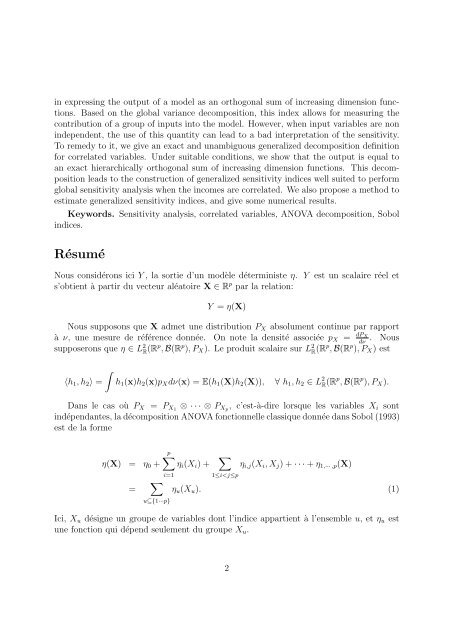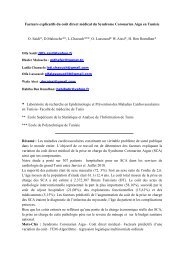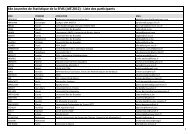Généralisation de la décomposition de Hoeffding-Sobol ... - JdS'2012
Généralisation de la décomposition de Hoeffding-Sobol ... - JdS'2012
Généralisation de la décomposition de Hoeffding-Sobol ... - JdS'2012
Create successful ePaper yourself
Turn your PDF publications into a flip-book with our unique Google optimized e-Paper software.
in expressing the output of a mo<strong>de</strong>l as an orthogonal sum of increasing dimension functions.<br />
Based on the global variance <strong>de</strong>composition, this in<strong>de</strong>x allows for measuring the<br />
contribution of a group of inputs into the mo<strong>de</strong>l. However, when input variables are non<br />
in<strong>de</strong>pen<strong>de</strong>nt, the use of this quantity can lead to a bad interpretation of the sensitivity.<br />
To remedy to it, we give an exact and unambiguous generalized <strong>de</strong>composition <strong>de</strong>finition<br />
for corre<strong>la</strong>ted variables. Un<strong>de</strong>r suitable conditions, we show that the output is equal to<br />
an exact hierarchically orthogonal sum of increasing dimension functions. This <strong>de</strong>composition<br />
leads to the construction of generalized sensitivity indices well suited to perform<br />
global sensitivity analysis when the incomes are corre<strong>la</strong>ted. We also propose a method to<br />
estimate generalized sensitivity indices, and give some numerical results.<br />
Keywords. Sensitivity analysis, corre<strong>la</strong>ted variables, ANOVA <strong>de</strong>composition, <strong>Sobol</strong><br />
indices.<br />
Résumé<br />
Nous considérons ici Y , <strong>la</strong> sortie d’un modèle déterministe η. Y est un sca<strong>la</strong>ire réel et<br />
s’obtient à partir du vecteur aléatoire X ∈ R p par <strong>la</strong> re<strong>la</strong>tion:<br />
Y = η(X)<br />
Nous supposons que X admet une distribution PX absolument continue par rapport<br />
à ν, une mesure <strong>de</strong> référence donnée. On note <strong>la</strong> <strong>de</strong>nsité associée pX = dPX . Nous<br />
dν<br />
supposerons que η ∈ L2 R (Rp , B(Rp ), PX). Le produit sca<strong>la</strong>ire sur L2 R (Rp , B(Rp ), PX) est<br />
<br />
〈h1, h2〉 =<br />
h1(x)h2(x)pXdν(x) = E(h1(X)h2(X)), ∀ h1, h2 ∈ L 2 R(R p , B(R p ), PX).<br />
Dans le cas où PX = PX1 ⊗ · · · ⊗ PXp, c’est-à-dire lorsque les variables Xi sont<br />
indépendantes, <strong>la</strong> <strong>décomposition</strong> ANOVA fonctionnelle c<strong>la</strong>ssique donnée dans <strong>Sobol</strong> (1993)<br />
est <strong>de</strong> <strong>la</strong> forme<br />
η(X) = η0 +<br />
=<br />
<br />
p<br />
ηi(Xi) + <br />
i=1<br />
u⊆{1···p}<br />
1≤i




